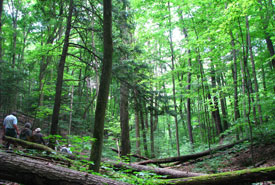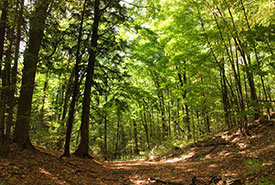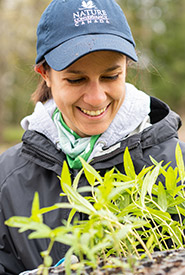Ain’t no mountain high enough

Hikers in Happy Valley Forest, ON (Photo by NCC)
So, you’re the master of hiking up hills in the Greater Toronto Area, are you? You take the stairs over the escalator at the shopping mall. You’ve conquered the stair climber at your local gym. Perhaps you’ve even climbed the CN tower for charity! And, when you reach the top, you feel like a superhero, and you can’t stop smiling. If heading higher and higher up the hills with a smile on your face is your thing, then you need not look very far. Happy Valley Forest, just one hour north of Toronto, can satisfy that craving.
The Happy Valley Forest natural area boasts a rolling landscape that provides a challenge, even for the most experienced hiker, thanks to its location on the Oak Ridges Moraine. A unique feature in southern Ontario, this moraine topography was formed during the last glaciation, 12,000 years ago. When the two-kilometre-thick glaciers began to melt, a crack formed between them, allowing meltwater channels to carry and position layers of sediment, including gravel, sand and silt. This created the moraine, which rises up to 300 metres high, and extends from the Niagara Escarpment to the east end of Rice Lake (about one third the size of Prince Edward Island).
Related blog posts
Initially after the glaciers melted in the area, about 9,000 years ago, the moraine and Happy Valley Forest looked very different from how they appear today. Colder temperatures allowed for recolonization of the area by small tundra vegetation, but this quickly gave way to the establishment of coniferous trees, including spruce, pine and fir found in the boreal forests of northern Ontario. Today, the moraine supports a combination of mature deciduous and mixed forest on its rolling landscape.

Happy Valley Forest, ON (Photo by NCC)
Why should we be so protective of this huge pile of glacial sediment? In part, for any more rain that’s to fall (insert groan here). But really, the moraine has an important role as a large filter for rainwater, as it seeps down into a large pool of subterranean water, an aquifer. The aquifer itself is an important source of fresh water. The moraine is also the beginning, or headwaters, of more than 30 river systems that flow into either Lake Ontario or Lake Simcoe. As a result, the moraine is a valuable water source for several regional municipalities, as well as a variety of unique aquatic and terrestrial ecosystems. This includes woodlands, wetlands, kettle lakes, shorelines, savannahs and prairies. In this way, the moraine also provides a corridor with a diversity of habitats for wildlife, with Happy Valley Forest being the largest, continuous patch of protected forest on the moraine.
Evidently, there’s a lot more to the moraine and Happy Valley Forest than meets the eye. So, the next time you go to Happy Valley Forest for a challenging, hilly hike, groaning or smiling up each rolling hill, take a moment to consider that you’re walking through a piece of Ontario’s unique natural history. Being distracted by the surrounding, beautiful forest will make each hill fly by, and before long, you will have climbed the equivalent of half of the CN tower in flights of stairs!


